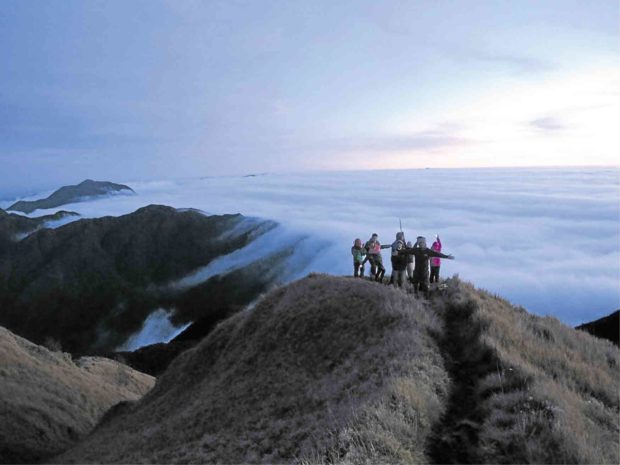
SEA OF CLOUDS A group of trekkers enjoys a breathtaking view of clouds from the summit of Mt. Pulag in the Cordillera. —EZRA ESPIRITU/CONTRIBUTOR
BAGUIO CITY — The next time mountain hikers are allowed back to Mt. Pulag, they must bring along fire extinguishers to set up camp at Luzon’s highest peak, an environment official said here.
Pulag trekkers may be barred from climbing toward the summit for at least six months or until July, to allow the mountain to heal following a Jan. 20 fire started by hikers, said Ralph Pablo, Cordillera regional director of the Department of Environment and Natural Resources (DENR).
The hikers were cooking rice using a butane stove when it exploded, prompting a member of the group to hurl the stove toward the grassland at the Saddle camp of the Mt. Pulag National Park.
The blaze destroyed 5.9 hectares of grassland which represent 1.5 percent of the 387-ha grassland summit of the park.
A bush fire also struck Mt. Ulap in Itogon town in Benguet province shortly after 6 p.m. on Monday. The blaze raged for almost three hours until firefighters from Philex mines put it under control at 9 p.m.
Dwarf bamboo
The 11,000-ha Mt. Pulag National Park is classified as a critical biodiversity area because of its rich plant and animal life. The park, which straddles five towns in the provinces of Benguet, Ifugao and Nueva Vizcaya, is home to rare animals, like the cloud rat, which thrive in the mossy forest. The Luzon shrew is known to populate the grassland summit.
But a biodiversity management expert said it would take a year for that portion of Mt. Pulag to recover from the fire. Roberto Cereno, director of the Training Center for Tropical Resources and Ecosystem Sustainability of the University of the Philippines Los Baños, said the fire hit specifically Saddle camp, which is closest to the summit and is mainly covered with dwarf bamboo.
Dwarf bamboo, he said, is a type of grass whose presence in the country is “unique” to Mt. Pulag and Mt. Halcon in Oriental Mindoro province. Its growth is naturally stunted because of its full exposure to the sun and strong winds and the minimal nutrients in the soil compared with other rainforests, he said.
“Still there were microorganisms, insects disturbed. Something was still killed (in that fire),” he said.
Mt. Pulag, Luzon’s highest peak, is a popular destination among outdoor enthusiasts. —EZRA ESPIRITU/CONTRIBUTOR
Cereno, who had cowritten a book on the conservation and management of protected areas in the Philippines, said a local guide could have prevented the incident. Local guides are a requirement when hiking inside the Mt. Pulag National Park.
While the dwarf bamboo will naturally regrow, it may take a year for its recovery given that there will be no landslides or human intervention, Cereno said. He recommended the closure of the campsite as well as the popular Akiki trail during the recovery.
Protected area
He also renewed calls for a law declaring Mt. Pulag a protected area. He said of the 239 protected areas in the country, only 10 to 13 sites had been declared through a law, while the rest only through a presidential decree.
Pablo said the Saturday fire “was not a bush fire so the impact is not that big and grasslands are usually burned [so these could] regenerate.” The grasslands also caught fire in 2003.
Citing a set of recommendations from the Bureau of Fire Protection, the DENR may require Pulag visitors to bring two fire retardant tanks if they intend to camp out at the summit.
“There is no water at the summit to douse any fire. Had there been water or a fire extinguisher, the campers may not have panicked and would have controlled the blaze,” Pablo said.
While the Akiki trail could be closed for five to six months to allow the grasslands to regrow, trekkers could still take the Ambangi trail, which leads to the park’s tower site and peak where they can observe a sea of clouds, he said.
Trekkers flock to Mt. Pulag in January and February to experience the freezing temperature. The temperature at the summit drops below 10 degrees Celsius.